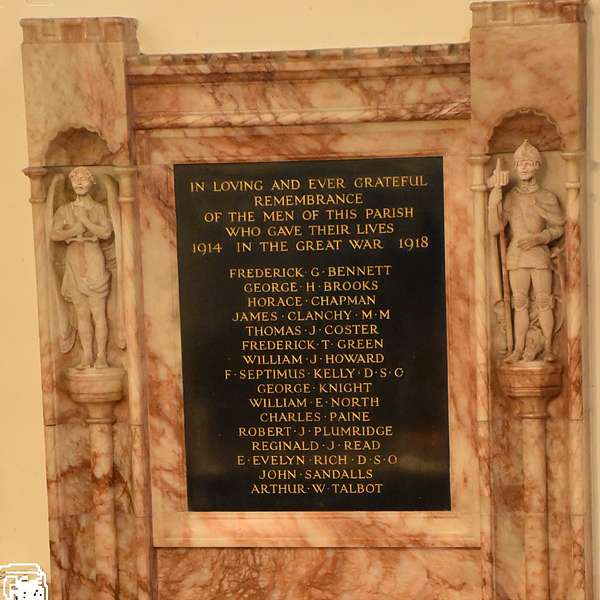
In the Shadow of the Abbey
In the Shadow of the Abbey
The War Years; 1921: War Memorial Tablet 'Eternal Honour to their Names'
Burial of the unknown soldier, Bisham Memorial Tablet unveiled, start of the school bus from Hurley, carving class delivers, no bathing in July.
Life was taking longer than expected to get back to normal; “In my last letter I referred to the difficulties and anxieties which the years of war had caused, and which had still to be faced with patience and courage. Our hopes that the troubled sea would calm down have not yet been fulfilled. The past year has been marked by a sad prevalence of doubts, disputes, distractions and fears”.
November 1920 was the burial of the unknown soldier in London, intended to focus the grief of the nation. At 10.50 on November 11th, the gun carriage carrying the casket reached the Cenotaph, newly built in Portland stone. The King added a handwritten note ‘in proud memory of those who died unknown in the Great War. As unknown and yet well-known; as dying and behold they live. George R I November 11th 1920.
Reverend Farrer records “Meanwhile our parish life has been of the happy kind that has no history. The chief event in our Parish was the completion of our War Memorial in the Church.” The Memorial Tablet and the Altar Rails were erected in time for the dedication service. “It is a matter of deep satisfaction to us all that we have been able to commemorate those whose names are inscribed upon it in such a handsome and worthy form.” Sixteen names were inscribed. All who have seen the Memorial with the names so clearly written in letters of gold and the beautiful figures of St Michael and St George on either side are unanimous in their admiration of Mr Cogswell’s design. The tablet itself cost £306-6-0, the rent on George Harding’s house for a year was £14-0-0.
In the School the chief change was, “The decision of the Berkshire Education Committee to send children from Hurley to our school. Some 20 children are conveyed from and to Hurley by motor car daily. We received a most generous gift of money for a Treat for the school children at Christmas. The gift was very much appreciated and the children had a very happy evening.
The Women’s Institute had a very successful first year, the meetings were well attended and were very popular. “The Carving Class in the Church was held about 30 times and Mr A. Ellis and Mr Jones kindly helped me on those evenings. The attendance was lowered by the counter attraction of the billiard table at the Institute.” The Billiard Table and the New Room and Cloak Rooms added greatly to the attraction of the Club.
The rainfall for 1920 was 3 inches below the average of 25.03 inches. July was very wet and cold 5.46 was the fall in the month. The cold weather made bathing unpopular.
The football club had a very successful season, the games have been well contested and much enjoyed.
Episode researched, written and narrated by Sheila Featherstone-Clark based on The Bisham Parish Report of May 1921. Revd W Farrer is voiced by Nigel Greenwich.
Episode Image is the War Memorial Tablet in Bisham Church.
Sound effects from www.Freesound.org. Last Post (MIDI Bugle by Neville Young) Organ playing (FK_Prod), Handbell for the school (Webbfilmsuk) , cricket match (Oroboros).
The War Years music is Shine by Herb Wiedoeft and the Cinderella Roof Orchestra from 1923.